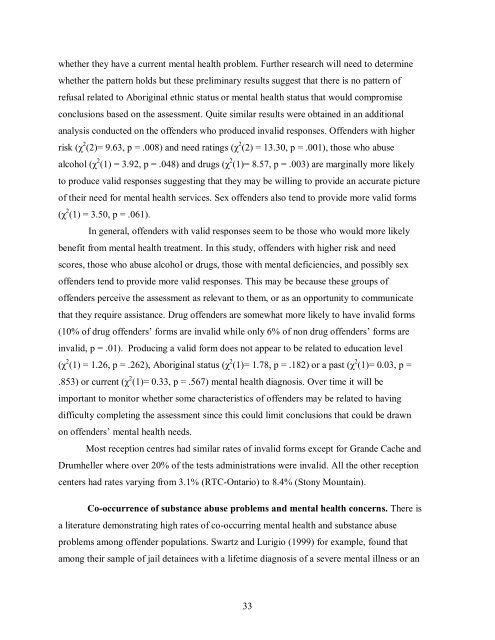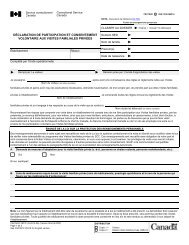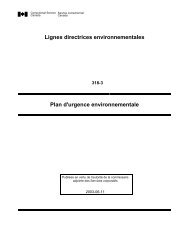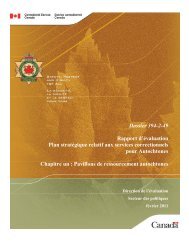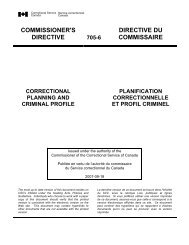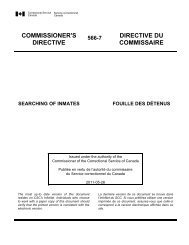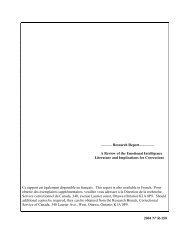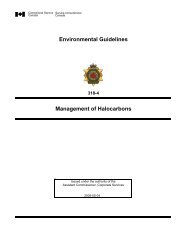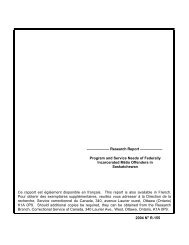The Brief Symptom Inventory (BSI) - Service correctionnel du Canada
The Brief Symptom Inventory (BSI) - Service correctionnel du Canada
The Brief Symptom Inventory (BSI) - Service correctionnel du Canada
Create successful ePaper yourself
Turn your PDF publications into a flip-book with our unique Google optimized e-Paper software.
whether they have a current mental health problem. Further research will need to determine<br />
whether the pattern holds but these preliminary results suggest that there is no pattern of<br />
refusal related to Aboriginal ethnic status or mental health status that would compromise<br />
conclusions based on the assessment. Quite similar results were obtained in an additional<br />
analysis con<strong>du</strong>cted on the offenders who pro<strong>du</strong>ced invalid responses. Offenders with higher<br />
risk (χ 2 (2)= 9.63, p = .008) and need ratings (χ 2 (2) = 13.30, p = .001), those who abuse<br />
alcohol (χ 2 (1) = 3.92, p = .048) and drugs (χ 2 (1)= 8.57, p = .003) are marginally more likely<br />
to pro<strong>du</strong>ce valid responses suggesting that they may be willing to provide an accurate picture<br />
of their need for mental health services. Sex offenders also tend to provide more valid forms<br />
(χ 2 (1) = 3.50, p = .061).<br />
In general, offenders with valid responses seem to be those who would more likely<br />
benefit from mental health treatment. In this study, offenders with higher risk and need<br />
scores, those who abuse alcohol or drugs, those with mental deficiencies, and possibly sex<br />
offenders tend to provide more valid responses. This may be because these groups of<br />
offenders perceive the assessment as relevant to them, or as an opportunity to communicate<br />
that they require assistance. Drug offenders are somewhat more likely to have invalid forms<br />
(10% of drug offenders’ forms are invalid while only 6% of non drug offenders’ forms are<br />
invalid, p = .01). Pro<strong>du</strong>cing a valid form does not appear to be related to e<strong>du</strong>cation level<br />
(χ 2 (1) = 1.26, p = .262), Aboriginal status (χ 2 (1)= 1.78, p = .182) or a past (χ 2 (1)= 0.03, p =<br />
.853) or current (χ 2 (1)= 0.33, p = .567) mental health diagnosis. Over time it will be<br />
important to monitor whether some characteristics of offenders may be related to having<br />
difficulty completing the assessment since this could limit conclusions that could be drawn<br />
on offenders’ mental health needs.<br />
Most reception centres had similar rates of invalid forms except for Grande Cache and<br />
Drumheller where over 20% of the tests administrations were invalid. All the other reception<br />
centers had rates varying from 3.1% (RTC-Ontario) to 8.4% (Stony Mountain).<br />
Co-occurrence of substance abuse problems and mental health concerns. <strong>The</strong>re is<br />
a literature demonstrating high rates of co-occurring mental health and substance abuse<br />
problems among offender populations. Swartz and Lurigio (1999) for example, found that<br />
among their sample of jail detainees with a lifetime diagnosis of a severe mental illness or an<br />
33


